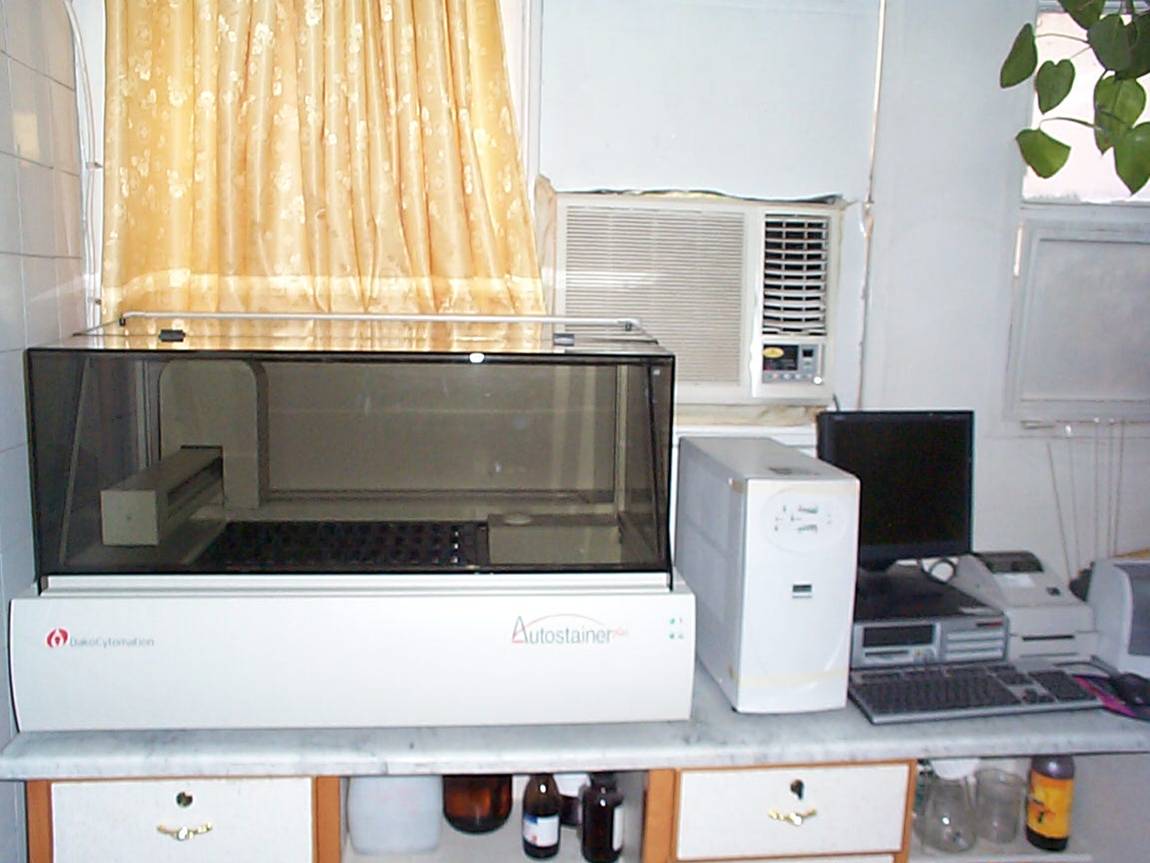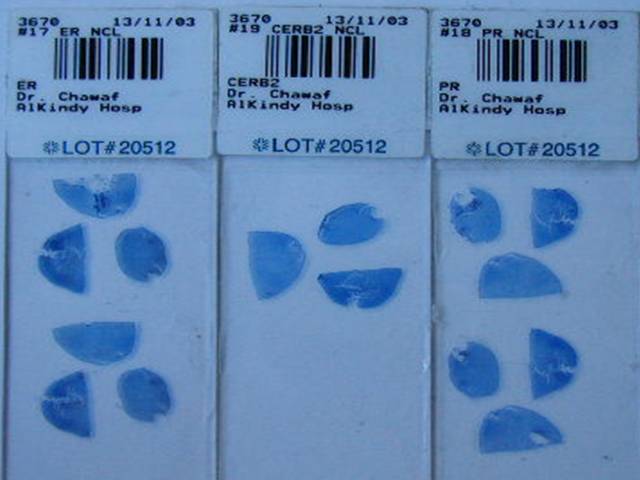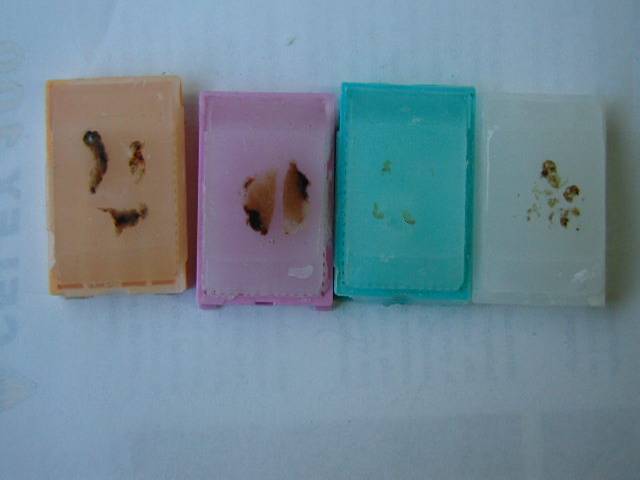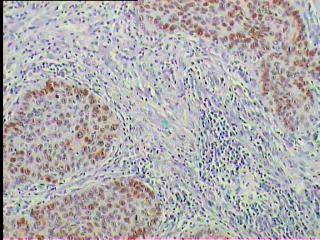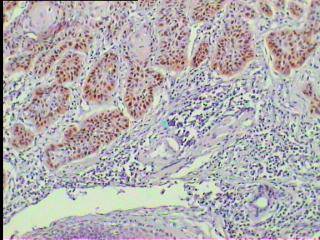مرحبا بك في هذا المنتدى !
يبدو أنك جديد هنا. إذا كنت تريد أن تتورط، انقر فوق أحد هذه الأزرار!
روابط سريعة
الأقسام
- 9.5K جميع الأقسام
- العلوم الطبية الأساسية Basic Medical Sciences
- علم التشريح العام و الجنين Anatomy and Embryology
- علم وظائف الأعضاء (الفيزيولوجيا) Physiology
- علم النسج Histology
- علم النسج العام ( عدا الأسنان ) General Histology
- علم النسج الخاص بالأسنان Oral histology
- علم الخليةو الحياة Biology
- علم التشريح المرضي Pathology
- التشريح المرضي العام ( عدا الأسنان ) Pathology
- التشريح المرضي الخاص بالأسنان Oral Pathology
- علم الأحياء الدقيقة Microbiology
- الجراثيم و الفيروسات Germs and Viruses
- الطفيليات الطبية Parasitology
- الفطور و الحشرات Insects and Fungi
- علم الوراثة الطبية Medical Genetics
- علم المناعة الطبية Medical Immunology
- 4 العلوم الطبية السريرية Clinical Medical Sciences
- الأمراض الداخلية Internal Medicine
- 4 الجراحة Surgery
- التوليد و الأمراض النسائية Gynacology & Obstetrics
- الصحة الجنسية Sexual Health
- طب الأطفال Pediatrics
- الجلدية Dermatology
- العينية Ophthalamology
- انف و أذن و حنجرة Ear, Nose, and Throat
- الطب المخبري labratory Medicine
- علم الأورام Oncology
- الطب الشرعي Forensic Medicine
- الطب النفسي Psychiatric
- التغذية والطب البديل Nourishments and Alternative Medicine
- طب الطوارئ و الإسعافات الأولية Emergency Medicine And Primary aids
- متلازمات طبية Medical Syndromes
- علم الأشعة Radiology
- طب الأسنان Dental Medicine
- التعويضات المتحركة الكاملة و الجزئية Removable Prothodontics
- المداواة الترميمية operative dentistry
- المداواة اللبية Endodontics
- طب أسنان الأطفال Pediatric Dental
- جراحة الوجه والفكينoral surgery
- التعويضات الثابتة Fixed Prothodontics
- المواد السنية dental materials
- النسج حول السنية periodontology
- التقويم Orthodontics
- منتدى فنيي الأسنان dental technicians
- طب الفم العام general oral medicine
- علم الأشعة Radiology
- حالات سريريةClinical Cases
- أخر مستجدات طب الأسنان last news
- المنتدى الطبي السني العامgeneral dentistry
- علم الصيدلة Pharma
- علم الأدوية
- علم الأدوية Pharmacology
- أدوية الطوارئ Emergency drugs
- المضادات الحيوية Antibiotics
- الأدوبة المسببة للتشوهات الجنينية Teratogenic drugs
- أدوية Drugs
- علم الكيمياء Chemistry
- كيمياء حيوية سريرية Clinical Biochemistry
- الكيمياء العامة و العضوية و الفيزيائية General & organic chemistry & physical
- الكيمياء الحيوية Biochemistry
- الكيمياء التحليلية و التحليل الآلي Analytical chemistry and the automated analysis
- علم عقاقير Pharmacognosy
- الطب البديل Alternative Medicine
- علم الأعشاب الصيدلانية Pharmaceutical Herbs
- التكنولوجيا الصيدلية Pharmatical technology
- الصيدلانيات Pharmaceutics
- الصيدلة الحيوية والحرائك الدوائية Biopharmaceutics & Pharmacokinetics
- الصناعة الدوائية Drug Industry
- علم السموم Toxicology
- الوصفات الطبية Prescriptions
- صيدلية المجتمع و أدوية OTC Medicines OTC
- الكيمياء الصيدلية Pharmaceutical chemistry
- الصيدلة سريرية و صيدلية المشافي Clinical & Hospital Pharmacy
- دمويات و مناعيات hematology & immunology
- مراقبة جودة الأدوية Drug Quality Control
- البيولوجيا الجزيئية Molecular Biology
- الصحة العامة و تلوث البيئة General Health
- المنتدى الصيدلاني العام
- الجودة الغذائية Food quality
- قسم الجودة الطبية Department of Medical Quality
- قسم الجودة العام General Quality Department
- قسم السلامة والصحة المهنية Department of Occupational Safety and Health
- قسم جودة وسلامة الأغذية Department of Food Quality and Safety
- المنتدى الطبي العام
- المنتدى الطبي العام
- منتدى العلوم والتكنولوجيا الطبية Medical Technology
- قانون و أخلاقيات المهنة
- تاريخ و آداب الطب
- الدراسات العليا و الدراسة في الخارج
- امتحانات Medical Exams
- تبادل الكتب الطبية و الميديا و البيانات الطبية
- مواضيع طبية غير مصنفة
- قسم الأسرة و المجتمع
- العناية بالمرأة الحامل و المرضع
- تربية الأطفال
- الصحة العامة
- التغذية الصحية و الغذاء الصحي
- أسريات
- 2 استراحة العيادة السورية
- المنتدى العام
- نشاطات و ترفيه
- 1 إسلاميات
- تطوير الذات و البرمجة اللغوية العصبية NLP
- المنتدى التقني
- مكتبة الصور و التصميم
- 1 المنتدى الثقافي و الأدبي
- المنتدى الرياضي
- منتدى اللغات Foriegn Languages
- الساحة العامة
- ساحة الحوار و النقاش
- ترحيب و تعارف
- قسم الاستشارات الطبية
- البحوث والندوات العلمية
- الاقتراحات و التطويرات
- الأقــســـام الــعـــامــة
- منتدى الحوار العام
- المواضيع العامة القديمة المستردة
- المواضيع الحاوية على مرفقات
Keratoacanthoma
[align=right]عنوان البحث[/align]
•The interpretation of benign biologic behavior for Keratoacanthoma versus Cutaneous Squamous Cell Carcinoma, using a panel of antibodies against : EGFR , P21 ras, P53 , Cyclin D1
[align=right]هدف البحث[/align]
[align=right]Introduction[/align]
•The keratoacanthoma (KA) is a relatively common tumor which most often occurs on the sun – exposed areas of light skinned individuals of middle age and older.
•This tumor is regressing spontaneously ,so the recognition of the true nature of this tumor is of considerable practical and biological important
•It may be named as an aborted squamous cells carcinoma.?
•Its etiology is unlcear , although ultraviolet light , viruses, oncogenic chemicals, and epidermal growth factor have been considered.
•EGFR : is membrane growth factor receptor encoded by the Cerb 1 gene
•P21 ras: is a signal transducing ( cytoplasmic ) oncoprotein with GTP ase activity. Ras mutative abolishes GTP ase activity and results in constitutive stimulation of the way.
•P 53 Nuclear protein playing an important protective role in the response to DNA damage induced by ionizing radiation chemical carcinogens and viruses, by three man mechanisms :
1- G1 arrest by induction of WAF 21 factor.
2- DNA damage repair by induction of GADD 45.
3- Induction of apoptosis in a situation of DNA damage repair failure.
* Cyclin D 1: CDK Complex regulates the RB protein ( PRB) . Mutational gene causes hyperphosphory lat of RB protein .with consultative stimulation of the pathway
•The expression of P21 ras was more evident in KA versus SCC (14/24 -58 % in KA versus 5/26- 19% in SCC ( P < 0.05)
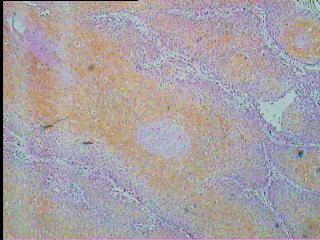 \
\
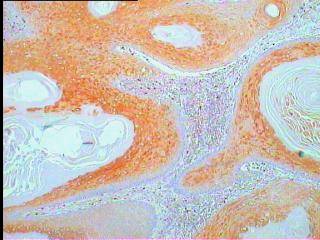
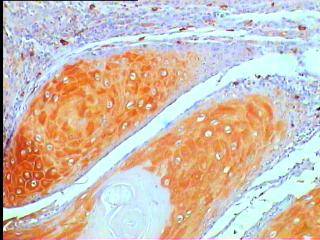
•EGFR was negative in both all cases of KA and SCC
•But focally expressed in the neighboring reactive epithelium
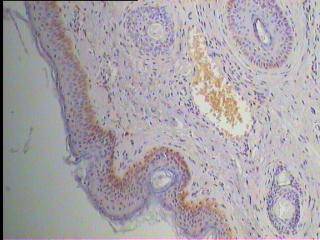
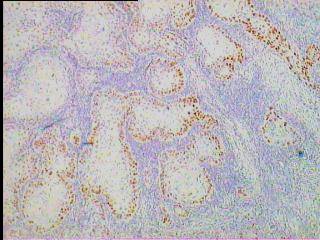
•Cyclin D1 showed more evident ( focal expression ) in SCC ( 10/26 -38% in SCC versus 4/24 – 16 % in KA )
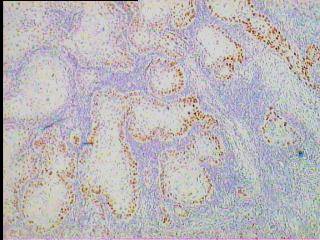
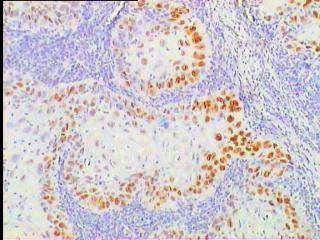
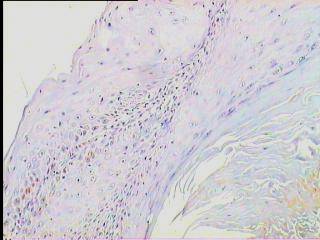
•- Our results refer to the decisive role of P53 mutation in the development of SCC and Its invaluable role in setting down a convincing diagnosis of SCC.
•- P21 ras was more definitive in KA
•- EGFR : is expressed more in reactive and benign epidermal growths , and has no role in both KA and SCC.
•– P53 mutation is critical and decisive in the development of cutaneous malignancy.
•- Cutaneous malignancy may be ascribed more to mutation in nuclear oncoproteins
•1- Petersen S, Iggo R,Corradin G.
Cytotoxic T epitopes in P53 protein: effect of mutation and polymorphism on peptide binding to purified and refold HLA molecules.
( Scand J Immunol.2001 ;53: 357-64)
•2- Lu S, Tiesko J, Hietnen S, Syrjanen K.
Expression of cell-cycle protein P53(WAF-1),PCNA and Ki67 in Benign , pre - malignant and malignant skin lesions with implicated HPV involvement.
( Acta Derm Venereolo. 1999 Jul,790(4) :268-73.
•3- Vielba R,Bilbao J,Ispizua I,
P53 and Cyclin D1 as prognostic factors in SCC of the larynx.
(Laryngoscop.2003 jan:113(1):167-72
•4- L Mortier MD, PM Danze PhD, P Plouvier,
Comparison of Keratoacanthoma and SCC, the point of view of micro satellites.
( 7th International Symposium on Predictive Oncology. February 7-10 , 2004 )
•5- A.P.B. Black & G.S.OGG.
The role of P53 in the immunobiology of cutaneous SCC.
( Clinical & experimental Immunology Volume 132 Issue 3 page 379 –June 2003-60
•6- Hernandez J, Lee PP, Davis MM, Sherman LA.
•The use of HLA 2,1 /p53 peptide teramers to visualize the impact of self tolerance on the TCR repertoire.
•J Immunol. 2000;164:596-602
•7- Ferries E,Connan F, Pages F et al.
•Identification of p53 peptides recognized by CD 8 (+) T lymphocytes from patients with bladder cancer.
•Hum Immunol 2001;62:791-8
•8- Moch C, Moysan A, Lubin R et al.
•Divergence between the high rate P 53 mutations in skin carcinomas and the low prevalence of anti – P 53 antibodies.
•Br. J cancer 2001;85:1883 – 6.
•تفسير السلوك البيولوجي السليم للشوكوم المتقرن بالمقارنة مع السرطانة حرشفية الخلايا في الجلد باستخدام طاقم الأضداد المناعية تجاه :
•EGFR ، P21ras, P53 , Cyclin D1•The interpretation of benign biologic behavior for Keratoacanthoma versus Cutaneous Squamous Cell Carcinoma, using a panel of antibodies against : EGFR , P21 ras, P53 , Cyclin D1
[align=right]هدف البحث[/align]
•دراسة تعبير عدة مورثات ورمية تمثل مختلف مناحي التسرطن في الخلية :
• EGFR كمستقبلة غشائية
• P21 ras كناقلة للإشارة في الهيولى
•P53 كمورثة كابحة للورم ومنظمة للإنتساخ الDNA
•Cyclin D1 كبروتين منظم لإدارة الخلية ويعمل في تنظيم نشاط المورثة الكابحة للورم Rb
• EGFR كمستقبلة غشائية
• P21 ras كناقلة للإشارة في الهيولى
•P53 كمورثة كابحة للورم ومنظمة للإنتساخ الDNA
•Cyclin D1 كبروتين منظم لإدارة الخلية ويعمل في تنظيم نشاط المورثة الكابحة للورم Rb
•البحث عن النقطة الفاصلة بين الشوكوم المتقرن باعتباره كارسينوما مجهضة
( متراجعة ) والسرطانة الحرشفية في الجلد من خلال دراسة تعبير هذه المورثات السابقة الذكر.
The aim of this work was to unmask the molecular relation of this tumor to SCC by studying the expression of a set of oncoproteins : EGFR (Epithelial Growth Factor Receptors,P21 ras , P53 ,Cyclin D1. ( متراجعة ) والسرطانة الحرشفية في الجلد من خلال دراسة تعبير هذه المورثات السابقة الذكر.
[align=right]Introduction[/align]
•The keratoacanthoma (KA) is a relatively common tumor which most often occurs on the sun – exposed areas of light skinned individuals of middle age and older.
•This tumor is regressing spontaneously ,so the recognition of the true nature of this tumor is of considerable practical and biological important
•It may be named as an aborted squamous cells carcinoma.?
•Its etiology is unlcear , although ultraviolet light , viruses, oncogenic chemicals, and epidermal growth factor have been considered.
•EGFR : is membrane growth factor receptor encoded by the Cerb 1 gene
•P21 ras: is a signal transducing ( cytoplasmic ) oncoprotein with GTP ase activity. Ras mutative abolishes GTP ase activity and results in constitutive stimulation of the way.
•P 53 Nuclear protein playing an important protective role in the response to DNA damage induced by ionizing radiation chemical carcinogens and viruses, by three man mechanisms :
1- G1 arrest by induction of WAF 21 factor.
2- DNA damage repair by induction of GADD 45.
3- Induction of apoptosis in a situation of DNA damage repair failure.
* Cyclin D 1: CDK Complex regulates the RB protein ( PRB) . Mutational gene causes hyperphosphory lat of RB protein .with consultative stimulation of the pathway
•دراسة حوالي 50 حالة لمرضى أجري لهم استئصال شقي أو كامل بهدف التشخيص النسجي للآفات التالية:
• الشوكوم المتقرن والسرطانة الحرشفية مع دراسة عينات من الجلد الطبيعي كشاهد
•دراسة الحالات الحدية والمحيرة بين الشوكوم المتقرن والسرطانة الحرشفية
• الشوكوم المتقرن والسرطانة الحرشفية مع دراسة عينات من الجلد الطبيعي كشاهد
•دراسة الحالات الحدية والمحيرة بين الشوكوم المتقرن والسرطانة الحرشفية
•تلوين مناعي نسجي لبروتينات المورثات
•EGFR,P53, P21 ras, Cyclin D1
•دراسة مورفوميترية لتعبير هذه البروتينات الورمية
•دراسة كمية ونوعية لتعبير هذه البروتينات الورمية في الشوكوم المتقرن والسرطانة الحرشفية الخلايا.
•دراسة إحصائية مقارنة لتعبير هذه البروتينات الورمية في الورمين السابقين
•EGFR,P53, P21 ras, Cyclin D1
•دراسة مورفوميترية لتعبير هذه البروتينات الورمية
•دراسة كمية ونوعية لتعبير هذه البروتينات الورمية في الشوكوم المتقرن والسرطانة الحرشفية الخلايا.
•دراسة إحصائية مقارنة لتعبير هذه البروتينات الورمية في الورمين السابقين
Results
•The expression of P21 ras was more evident in KA versus SCC (14/24 -58 % in KA versus 5/26- 19% in SCC ( P < 0.05)
 \
\

•EGFR was negative in both all cases of KA and SCC
•But focally expressed in the neighboring reactive epithelium


•Cyclin D1 showed more evident ( focal expression ) in SCC ( 10/26 -38% in SCC versus 4/24 – 16 % in KA )



Conclusions
•- Our results refer to the decisive role of P53 mutation in the development of SCC and Its invaluable role in setting down a convincing diagnosis of SCC.
•- P21 ras was more definitive in KA
•- EGFR : is expressed more in reactive and benign epidermal growths , and has no role in both KA and SCC.
•– P53 mutation is critical and decisive in the development of cutaneous malignancy.
•- Cutaneous malignancy may be ascribed more to mutation in nuclear oncoproteins
•1- Petersen S, Iggo R,Corradin G.
Cytotoxic T epitopes in P53 protein: effect of mutation and polymorphism on peptide binding to purified and refold HLA molecules.
( Scand J Immunol.2001 ;53: 357-64)
•2- Lu S, Tiesko J, Hietnen S, Syrjanen K.
Expression of cell-cycle protein P53(WAF-1),PCNA and Ki67 in Benign , pre - malignant and malignant skin lesions with implicated HPV involvement.
( Acta Derm Venereolo. 1999 Jul,790(4) :268-73.
•3- Vielba R,Bilbao J,Ispizua I,
P53 and Cyclin D1 as prognostic factors in SCC of the larynx.
(Laryngoscop.2003 jan:113(1):167-72
•4- L Mortier MD, PM Danze PhD, P Plouvier,
Comparison of Keratoacanthoma and SCC, the point of view of micro satellites.
( 7th International Symposium on Predictive Oncology. February 7-10 , 2004 )
•5- A.P.B. Black & G.S.OGG.
The role of P53 in the immunobiology of cutaneous SCC.
( Clinical & experimental Immunology Volume 132 Issue 3 page 379 –June 2003-60
•6- Hernandez J, Lee PP, Davis MM, Sherman LA.
•The use of HLA 2,1 /p53 peptide teramers to visualize the impact of self tolerance on the TCR repertoire.
•J Immunol. 2000;164:596-602
•7- Ferries E,Connan F, Pages F et al.
•Identification of p53 peptides recognized by CD 8 (+) T lymphocytes from patients with bladder cancer.
•Hum Immunol 2001;62:791-8
•8- Moch C, Moysan A, Lubin R et al.
•Divergence between the high rate P 53 mutations in skin carcinomas and the low prevalence of anti – P 53 antibodies.
•Br. J cancer 2001;85:1883 – 6.
من محاضرات الدكتور :ثائر الدوري

